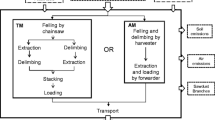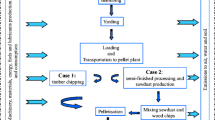Abstract
Purpose
Forest residues are becoming an increasingly important bioenergy feedstock. This study evaluates the environmental impacts associated with the production of fuel chips from eucalypt logging residues in Portugal, in order to identify the supply chains and machinery that bring the best environmental performance. Besides, the stages and operations with the largest environmental impact are identified.
Methods
Life cycle assessment methodology is used starting with forest management up to delivery of chips to power plant. Three different configurations for logging residue processing were simulated as follows: roadside chipping of loose residues, terminal chipping of loose residues, and terminal chipping of bundled residues. In addition, the use of different equipment for tree felling and extraction of logging residue was considered. The default impact assessment methodology was the CML. In a sensitivity analysis, calculations were performed using characterization factors recommended by the International Reference Life Cycle Data System (ILCD). Different allocation criteria were tested for partitioning the environmental burdens between wood and forest residues produced during the stage of forest management.
Results and discussion
Roadside chipping of loose residues seems to have less impacts regardless of the equipment used in tree felling and residue forwarding. However, for photochemical oxidant formation, this is not the case when trees are felled with a chainsaw when the CML methodology is applied. For the systems with terminal chipping, the better option will depend both on type of machinery used and distances traveled between the forest site and the power plant. The forest management stage has a relevant contribution to all the supply chains analyzed. Chipping and bundling have also important impacts, as well as forwarding when this operation is accomplished with a modified farm tractor. Moreover, transports have a significant impact when loose residues are chipped in a terminal.
Conclusions
The choice of the allocation method between wood and residues affects significantly the absolute results, but it is irrelevant when the objective is to select the best supply chain configuration. The results obtained are valid for the input data considered, which rely on average values representative of the current most typical practices in Portugal. However, this methodology can also be applied as a decision supporting tool to select the supply chain with the best environmental performance on a case by case basis, using site-specific data.






Similar content being viewed by others
Notes
Diesel, at regional storage/RER; petrol, two-stroke blend, at regional storage/RER; lubricating oil, at plant/RER; ammonium sulphate, as N, at regional storehouse/RER; triple superphosphate, as P2O5, at regional storehouse/RER; potassium chloride, as K2O, at regional storehouse/RER.
References
AFLOBEI (2012) Preços indicativos dos produtos florestais. Folha Florestal 25:4
Athanassiadis D, Lidestav G, Wästerlund I (1999) Fuel, hydraulic oil and lubricant consumption in Swedish mechanized harvesting operations, 1996. J For Eng 10:59–66
Bright RM, Strømman AH (2009) Life cycle assessment of second generation bioethanols produced from Scandinavian boreal forest resources. A regional analysis for Middle Norway. J Ind Ecol 13:514–531
Butnar I, Rodrigo J, Gasol CM, Castells F (2010) Life-cycle assessment of electricity from biomass: case studies of two biocrops in Spain. Biomass Bioenergy 34:1780–1788
CBE (2004) Optimização das operações de exploração florestal, recolha, acondicionamento, transporte e transformação primária da biomassa florestal residual para a produção de energia. Centro da Biomassa para a Energia, Miranda do Corvo
CBE (2008) Utilização da biomassa florestal residual para aproveitamento energético. Centro da Biomassa para a Energia, Miranda do Corvo
Conselho de Ministros (2010) Resolução do Conselho de Ministros no 29/2010. Diário da República, 1.ª série, No. 73:1289-1296
Cuchet E, Roux P, Spinelli R (2004) Performance of a logging residue bundler in the temperate forest of France. Biomass Bioenergy 27:31–39
DGEG (2012) Renováveis estatísticas rápidas nº 90. Direcção Geral de Energia e Geologia, Lisbon
DGGE (2005) Renováveis estatísticas rápidas no. 10. Direcção Geral de Geologia e Energia, Lisbon
Dias AC, Arroja L (2012) Environmental impacts of eucalypt and maritime pine wood production in Portugal. J Clean Prod 37:368–376
Dias J, Azevedo JLT (2004) Evaluation of biomass residuals in Portugal Mainland. In: Afgan NH, Carvalho MDG (eds) International conference on new and renewable energy technologies for sustainable development, Ponta Delgada, pp 214-228
Dias AC, Arroja L, Capela I (2007) Carbon dioxide emissions from forest operations in Portuguese eucalypt and maritime pine stands. Scand J For Res 22:422–432
E2P (2012) Energias endógenas de Portugal – base de dados de fontes renováveis de energia. http://e2p.inegi.up.pt/index.asp. Accessed 17 December 2012
EC (2012) Characterisation factors of the ILCD recommended life cycle impact assessment methods. Database and supporting information. European Commission, Joint Research Centre, Institute for Environment and Sustainability, Luxembourg
Ecoinvent (2010) Ecoinvent database v 2.2. Swiss Centre for Life Cycle Inventories, Dübendorf
EEA (2009) EMEP/EEA air pollutant emission inventory guidebook 2009. EEA Technical Report 9/2009. European Environment Agency, Copenhagen
Eriksson LN, Gustavsson L (2008) Biofuels from stumps and small roundwood—costs and CO2 benefits. Biomass Bioenergy 32:897–902
Faix A, Schweinle J, Schöll S, Becker G, Meier D (2010) (GTI-tcbiomass) Life-cycle assessment of the BTO®-process (biomass-to-oil) with combined heat and power generation. Environ Prog Sustain Energy 29:193–202
Forsberg G (2000) Biomass energy transport—analysis of bioenergy transport chains using life cycle inventory method. Biomass Bioenergy 19:17–30
Gasol CM, Gabarrell X, Anton A, Rigola M, Carrasco J, Ciria P, Rieradevall J (2009) LCA of poplar bioenergy system compared with Brassica carinata energy crop and natural gas in regional scenario. Biomass Bioenergy 33:119–129
GERA (2012) Preços de produtos florestais. GERA—Gestão Rural Activa. http://www.gera.com.pt/. Accessed 3 December 2012
González-García S, Gasol CM, Gabarrell X, Rieradevall J, Moreira MT, Feijoo G (2010) Environmental profile of ethanol from poplar biomass as transport fuel in Southern Europe. Renew Energy 35:1014–1023
González-García S, Mola-Yudego B, Murphy RJ (2013) Life cycle assessment of potential energy uses for short rotation willow biomass in Sweden. Int J Life Cycle Assess 18:783–795
Guinèe J, Gorree M, Heijungs R, Huppes G, Kleijn R, de Koning A, van Oers L, Weneger A, Suh S, Udo de Haes H, de Bruin H, Duin R, Huijbregts M (2001) Life cycle assessment: an operational guide to the ISO standards. Ministry of Housing, Spatial Planning and the Environment and Centre of Environmental Science / Leiden University, Leiden
IPCC (2007) IPCC fourth assessment report: climate change 2007—the physical science basis. Cambridge University Press, Cambridge and New York
Johansson J, Liss L-E, Gullberg T, Björheden R (2006) Transport and handling of forest energy bundles—advantages and problems. Biomass Bioenergy 30:334–341
Johnson L, Lippke B, Oneil E (2012) Modeling biomass collection and woods processing life-cycle analysis. Forest Prod J 62:258–272
Klvac R, Ward S, Owende PMO, Lyons J (2003) Energy audit of wood harvesting systems. Scand J For Res 18:176–183
Kounina A, Margni M, Bayart J-B, Boulay A-M, Berger M, Bulle C, Frischknecht R, Koehler A, Motoshita M, Núñez M, Peters G, Pfister S, Ridoutt B, van Zelm R, Verones F, Humbert S (2013) Review of methods addressing freshwater use in life cycle inventory and impact assessment. Int J Life Cycle Assess 18:707–721
Laitila J (2008) Harvesting technology and the cost of fuel chips from early thinnings. Silva Fenn 42:267–283
Lindholm E-L, Berg S, Hansson P-A (2010) Energy efficiency and the environmental impact of harvesting stumps and logging residues. Eur J Forest Res 129:1223–1235
Lindholm E-L, Stendahl J, Berg S, Hansson P-A (2011) Greenhouse gas balance of harvesting stumps and logging residues for energy in Sweden. Scand J Forest Res 129:1223–1235
Mateus T (2007) O Potencial energético da floresta portuguesa: análise do potencial energético disponível para as centrais termoeléctricas a biomassa florestal lançadas a concurso. Faculdade de Engenharia da Universidade do Porto, Porto
Mattila T, Helin T, Antikainen R (2012) Land use indicators in life cycle assessment. Int J Life Cycle Assess 17:277–286
Mckechnie J, Colombo S, Chen J, Mabee W, Maclean HL (2011) Forest bioenergy or forest carbon? Assessing trade-offs in greenhouse gas mitigation with wood-based fuels. Environ Sci Technol 45:789–795
MEI (2007) Renewable energy in Portugal. Ministério da Economia e da Inovação, Lisbon
Nunes JMSA (2008) Avaliação integrada da produção de electricidade com base em biomassa lenho-celulósica em Portugal: emissões de GEE, análise tecnológica e energética de ciclo de vida. Master Thesis. Universidade de Coimbra, Coimbra
Núñez-Regueira L, Proupín-Castiñeiras J, Rodríguez-Añon JA (2002) Energy evaluation of forest residues originated from Eucalyptus globulus Labill in Galicia. Bioresource Technol 82:5–13
Nuss P, Gardner KH, Jambeck JR (2013) Comparative life cycle assessment (LCA) of construction and demolition (C&D) derived biomass and US Northeast forest residuals gasification for electricity production. Environ Sci Technol 47:3463–3471
Pa A, Craven JS, Bi XT, Melin S, Sokhansanj S (2012) Environmental footprints of British Columbia wood pellets from a simplified life cycle analysis. Int J Life Cycle Assess 17:220–231
Roedl A (2010) Production and energetic utilization of wood from short rotation coppice—a life cycle assessment. Int J Life Cycle Assess 15:567–578
Silva MTC (2009) Análise do balanço entre sequestro e emissão de CO2 resultante do circuito de produção e consumo de biomassa florestal numa central de co-geração. Master Thesis. Faculdade de Ciências e Tecnologia da Universidade Nova de Lisboa, Lisbon
Tomé M, Oliveira T, Soares P (2006) O modelo Globulus 3.0—dados e equações. Publicações GIMREF—RC2/2006. Centro de Estudos Florestais do Instituto Superior de Agronomia, Lisbon
Valente CA, Sousa APM, Furtado FP, Carvalho AP (1992) Improvement program for Eucalyptus globulus at Portucel: technological component. Appita J 45:403–407
Valente C, Hillring BG, Solberg B (2011a) Bioenergy from mountain forest: a life cycle assessment of the Norwegian woody biomass supply chain. Scand J Forest Res 26:429–436
Valente C, Spinelli R, Hillring BG (2011b) LCA of environmental and socio-economic impacts related to wood energy production in alpine conditions: Valle di Fiemme (Italy). J Clean Prod 19:1931–1938
Valente C, Hillring BG, Solberg B (2012) Greenhouse gas emissions, energy use, and costs—case studies of wood fuel supply chains in Scandinavia. Int J Forest Eng 23:71–81
van Oers L, de Koning, Guinèe JB, Huppes G (2002) Abiotic resource depletion in LCA. Road and Hydraulic Engineering Institute, Ministry of Transport and Water, Amsterdam
Viana H, Cohen WB, Lopes D, Aranha J (2010) Assessment of forest biomass for use as energy. GIS-based analysis of geographical availability and locations of wood-fired power plants in Portugal. Appl Energy 87:2551–2560
Whittaker C, Mortimer N, Murphy R, Matthews R (2011) Energy and greenhouse gas balance of the use of forest residues for bioenergy production in the UK. Biomass Bioenergy 35:4581–4594
Wihersaari M (2005) Greenhouse gas emissions from final harvest fuel chip production in Finland. Biomass Bioenergy 28:435–443
Yoshioka T, Aruga K, Nitami T, Kobayashi H, Sakai H (2005) Energy and carbon dioxide (CO2) balance of logging residues as alternative energy resources: system analysis on the method of a life cycle inventory (LCI) analysis. J For Res 10:125–134
Acknowledgments
This study has been supported by the project ECOTECH SUDOE—International Network on LCA and Ecodesign for Eco-innovation (SOE2/P2/E377) funded by the EU Interreg IV B Sudoe Programme. Thanks are also due to FCT (Science and Technology Foundation; Portugal) for the scholarship granted to Ana Cláudia Dias (SFRH/BPD/75788/2011). The author also expresses her gratitude to Luis Arroja (CESAM/DAO—University of Aveiro) for supervising her work and constructive comments.
Author information
Authors and Affiliations
Corresponding author
Additional information
Responsible editor: Christian Bauer
Rights and permissions
About this article
Cite this article
Dias, A.C. Life cycle assessment of fuel chip production from eucalypt forest residues. Int J Life Cycle Assess 19, 705–717 (2014). https://doi.org/10.1007/s11367-013-0671-4
Received:
Accepted:
Published:
Issue Date:
DOI: https://doi.org/10.1007/s11367-013-0671-4




